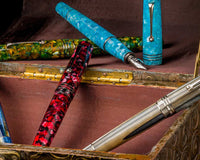The fountain pen has become an integral part of Japanese culture and tradition ever since its introduction to the country in the Meiji period (1868–1912).
At that time, the calligraphy brush was used most commonly as a writing tool. Still, the fountain pen proved to be the superior choice, and its usage increased rapidly in the coming years, which helped establish it as the default choice for modern Japanese citizens.
History
When fountain pens were first introduced into the Japanese market in the late 19th century, they were positioned as an extremely desirable imported good by sellers. This was done through various advertisements, writings, and essays regarding this topic. An example of this can be seen in an advertisement published in 1912 called Maruzen, Yo to Mannenhitsu (A Fountain Pen and I) by Sōseki Natsume.
 Natsume Sōseki
Natsume Sōseki
As time progressed, Japan entered the Taishō era of the 20th century. The fountain pen became known in Japan as a symbol of modernization, as it was seen as a superior alternative to the other options available at the time. This modernity could also be seen in the design of fountain pens, which focused more on using ink from inside the pen’s body, as opposed to dipping the nib in liquid. The growing popularity of fountain pens in Japan slowly led to an increase in local production as well, and this was compounded by the country’s manufacturing boom after World War 2.
Soon, Japan went from importing fountain pens to producing ones that rivaled those produced in Germany or Italy, and eventually became a leader in the industry. This was achieved through the Japanese manufacturers blending their country's traditions and practices with influences in the global markets.
Present Day
In today's world, Japanese fountain pens are renowned worldwide for their high-quality craftsmanship and long-lasting appeal. Some of the industry's biggest names are from Japan, such as Pilot, Platinum, and Sailor. They each played an instrumental role in establishing the Japanese fountain pen industry as the world's best.
 Pilot Custom Heritage 912, Platinum 3776 Century Oshino, Sailor 1911 Large Black Luster
Pilot Custom Heritage 912, Platinum 3776 Century Oshino, Sailor 1911 Large Black Luster
Pilot has been operating for almost 100 years, although it went through a name change. The Pilot Kakuno is known to be a great pen for beginners.
 Pilot 100th Anniversary Fuji and Meiji-Maru
Pilot 100th Anniversary Fuji and Meiji-Maru
Platinum was known as Nakaya until 1928 when it also went through a name change. Its most well-known pen is the Platinum 3776 Century, which reflects the significance of these pens as a symbol of Japanese history and culture, as 3776 is the height of the country's famous Mount Fuji.
 Nakaya 14K Two-Tone Medium Nib, Platinum 14K Single-Tone Fine Nib
Nakaya 14K Two-Tone Medium Nib, Platinum 14K Single-Tone Fine Nib
Sailor is one of the few pen manufacturers in Japan that has operated under the same name since its inception. Its pens are often viewed as highly desirable, with its ‘King of Pens’ range serving as the highlight.
 Sailor Pro Gear Slim 14K Rhodium Nib, Pro Gear 21K Two-Tone Nib, King of Pen 21K Single-Tone Nib
Sailor Pro Gear Slim 14K Rhodium Nib, Pro Gear 21K Two-Tone Nib, King of Pen 21K Single-Tone Nib
Even today, the fountain pen still plays a significant role in contemporary Japanese life. This is due to its prevailing use in Japanese popular culture, as it is seen as a symbol of personal identity. It is usually gifted to an individual to celebrate a major milestone, such as employment or graduation. The vibrant history, the merging of culture, and the lasting effects of tradition have placed the Japanese fountain pen industry as an integral part of the country's identity, bound to persevere for a long time.
By Some Folks at EndlessPens







